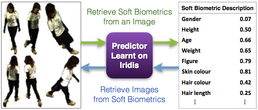Automatic Image Retrieval with Soft Biometrics for Surveillance
- Started
- 1st October 2014
- Research Team
- Daniel Martinho-Corbishley
- Investigators
- Mark Nixon, John Carter
We're investigating ways to automatically describe and identify pedestrians from surveillance footage using human understandable, soft biometric labels. Our goal is to enable surveillance operators to search for pedestrians in a video network using soft biometric descriptions, and to automatically retrieve these descriptions from CCTV images.
Retrieving identity cues from a limited number of low quality images proves challenging, especially when applied to surveillance footage, at-a-distance. Common biometrics like face, fingerprint or gait are often partially hidden or unobservable and therefore not applicable. To solve this problem, we focus on using soft biometrics to describe pedestrians from human discernible traits like: gender, height, age, hair colour etc. Soft biometrics are robust to variations in camera angle and lighting, bridging the ‘semantic-gap’ between computer and human description.
We have collected almost sixty-thousand human annotations comparing one-hundred human subjects taken from the Southampton Multi-Biometric Tunnel image dataset. Combining these precise human descriptions with a vast number of images from the tunnel dataset, we aim to generate models that predict subjects’ soft biometric traits directly from their images. We are investigating a number of computer vision and machine learning algorithms, ranging from Support Vector Machine (SVM) classifiers for colour, shape and texture, through to more elaborate techniques such as biologically inspired Recurrent Neural Networks (RNNs).
Learning prediction models from such a large training dataset requires numerous calculation tasks, and this is where the Iridis cluster is invaluable. Our learning algorithms do not require large amounts of memory, but they can consume as many processor cores as are available, which drastically reduces the calculation time compared to a single desktop computer. Iridis therefore, allows us to train many experimental setups on significantly sized training sets, and enables iterative improvements in learning the optimal soft biometric image retrieval models.
Categories
Physical Systems and Engineering simulation: Biometrics
Algorithms and computational methods: Artificial Neural Networks, Classification, Computer Vision, Machine learning, Multi-core, Support Vector Machine
Software Engineering Tools: Git, Sublime Text, Vim
Programming languages and libraries: CUDA, IPython/Jupyter Notebook, Python
Computational platforms: Iridis
Transdisciplinary tags: Computer Science, Scientific Computing
